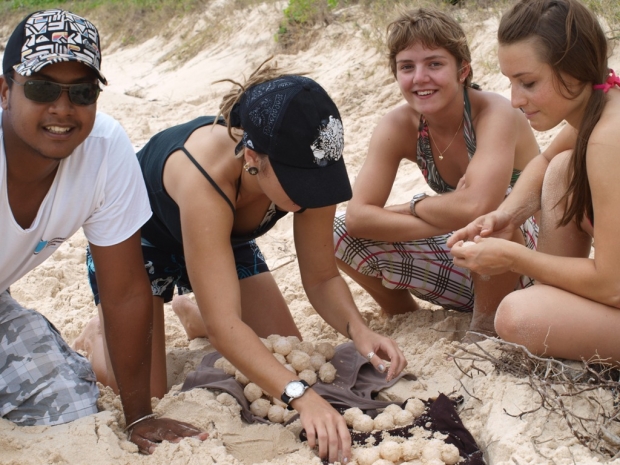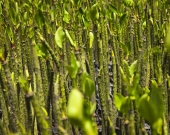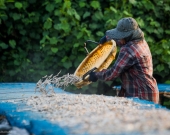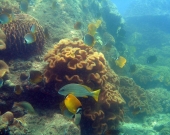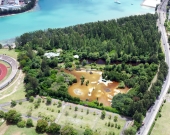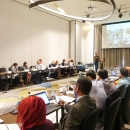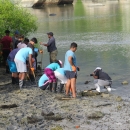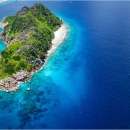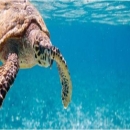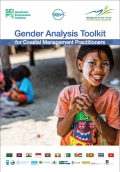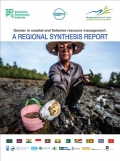MFF activities in the Seychelles include projects on habitat restoration and biodiversity protection, as well as contributing to environmental events. These activities are also helping to promote local community and private sector involvement in coastal resources management.
MFF is supporting the legal protection of coastal habitats and species, as well as helping to educate youth and local communities about their intrinsic values. Climate change is a major concern for the Seychelles, primarily because the country’s main economic sectors and infrastructure would be vulnerable to rising sea levels. MFF’s focus in this regard is to assist the government to implement the National Disaster Management Policy and to build community resilience to climate change.
The Seychelles consists of a group of 115 islands spread across an Exclusive Economic Zone (EEZ) of 1.3 million km² in the South Western Indian Ocean. There are 41 high granitic and 74 low lying coralline islands with a land area of 452 km². It has a coastline of 747 km with 1,690 km of coral reefs and 29 km² of mangroves. The climate is tropical with average annual rainfall exceeding 1000 mm and average temperature of 26ºC.
The islands consist of different terrestrial and marine ecosystems which form the coastal zone. The land is made up of forests, wetlands and streams.
Seven species of Mangroves are found at the intersection between land and marine environment. They protect shorelines by trapping sediments eroded from the land and also against wave erosion. They also offer some protection to the extensive coral reef system that comprises of coral reefs and sea grasses, with algae in certain parts. The complex network of coastal ecosystems has a critical role to play in maintaining the biodiversity of the archipelago.
The Seychelles has almost 45% of land under protection. The protected areas offer protection to the country’s biodiversity, much of which is unique to this part of the world. Some protected areas are being used to generate revenue for conservation management. There are good existing case studies whereby funds generated through entrance fees are being effectively used for the management of the protected area. Such cases include the management of Cousin Island Special Reserve and Vallée de Mai, which are under the management of Nature Seychelles and Seychelles Islands Foundation. There is potential for other protected areas to be developed as sustainably managed reserves.
The population of the Seychelles is estimated at 87,000 with the majority of inhabitants residing on the three main granitic islands; Mahé, Praslin and La Digue. Because of the steep topography of the granitic islands, most of the dwellings and development are located on the coastal plain and lower hill slopes usually located within a kilometre inland.
Tourism and fisheries are two of the main pillars of the country’s economy. Both sectors contribute over 40 percent towards the Gross National Product. Agriculture is an underdeveloped sector which contributes less than 5% towards the Gross Domestic Product.
Due to the small size and heterogeneity the Seychelles can be regarded as a coastal zone. In the Seychelles context, coastal zone can be defined as a contiguous system which includes human activities, landward areas, wetlands, sea grasses and coral reefs.
Integrated Coastal Zone Management in Seychelles
Since the whole archipelago is considered a coastal zone, Integrated Coastal Zone Management (ICZM) is considered a priority in Seychelles. The objective is to promote ICZM and at the same time implement ICZM programmes taking climate change concerns into consideration. A rise in sea level, may affect most of the economic sectors of the country. It is estimated that almost 95% of all socio-economic activities and other forms of development are located on the coastal plateaux. Such sensitivity is further enhanced by the fact that the main granitic islands rise up to almost a thousand metres (or almost 3000ft), with steep hill slopes which are prone to landslides. Hence, careful planning is required due to the fragility of the coastal zone.
The Seychelles National Strategy and Plan of Action (NSAP)
At local level, the Seychelles National Coordinating Body (NCB) has been formed where governments, Non-Governmental Organizations (NGOs), private sector and the local community work together to conserve and restore coastal ecosystems. A National Project Coordinator has also been recruited (with the assistance of United Nations Development Program, UNDP), overseeing the operationalization and implementation of the Small Grant Facility and hopefully the Large Project.
Implementation of the work programme is administered by a Regional Steering Committee (RSC) co-chaired by the International Union for the Conservation of Nature (IUCN) and United Nations Development Program (UNDP), with national representatives and institutional partners as its members. Seychelles being one of the six focal countries has developed a strategy setting out its approach to the sustainable development of its coastal areas which is a fundamental part of the development infrastructure. The Seychelles Country Strategy and Action Plan 2008 – 2009 represents the principles that will characterise the activities and projects which the country supports. Many of the 15 Programmes of Work (PoW) in the MFF Plan of Action (October 2006) have since been adopted within Seychelles Country Strategy.
The Strategy also shows how MFF can act as a leveraging mechanism to focus attention towards specific areas in need of urgent attention that could result in long term benefits to the coastal communities and coastal and marine environments. It suggests interventions, activities and criteria for assessing proposals for actions made by government, private sector and non-government organisations.
Small Grant Facilities (SGF)
The MFF Secretariat made available to the NCB a total of USD 100’000 to assist small projects which are in line with the NSAP and MFF Programme of work. The first call for proposal was launched in 2008 from which 4 applications were received and appraised and all were approved by the NCB following specific guidelines and guidance from the MFF Secretariat. SGF proponents receiving funding in July 2009 have now started implementation at ground level. The four grantees are the Marine Conservation Society of Seychelles, the Green Island Foundation, the Wildlife Clubs of Seychelles and the Seychelles Island Foundation, all addressing and supporting various community action in the restoration and management of coastal ecosystems and their services as a basis for sustainable development, serving as inspirational models for policy makers, building local capacity, enhancing public awareness, promoting innovative community based coastal restoration and rehabilitation projects... see table below. The SGF and the MFF initiative are receiving considerable attention and public support through their involvement and through the national media (newspaper and radio programmes). Additionally, the NCB has received a further USD 50’000 from the Secretariat which will be committed to support community based projects; some applications have already reached the Chair, awaiting NCB screening and appraisal soon using a set of criteria suggested by the NCB and the SGF Operational Guideline.
 Seychelles
Seychelles 